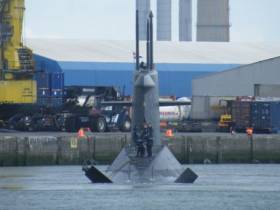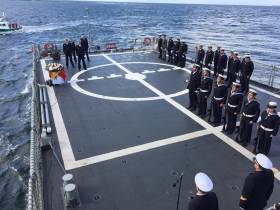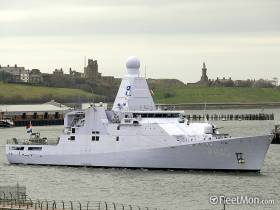Displaying items by tag: Naval Visits
Stealth Frigate Underway to Dublin for Call and Public Tours
#StealthShip - Presenting ‘stealth’ characteristics is frigate Provence of the French Navy which is to make a courtesy call to Dublin tomorrow and will be open at the weekend, writes Jehan Ashmore.
On Saturday the public are invited to board the slick 6,000 gross tonnage 'Aquitaine' class FREMM frigate. The visit will allow for a crew rest in the capital.
Measuring 142m long vessel, Provence is of the French Frégate européenne multi-mission (FREMM) programme in which the ship is the second of the class. The vessel was built in Brest by DCNS in 2015.
Provence is one of three active multiple-purpose frigates serving French Navy and they are equipped to operate during anti-submarine missions.
Among the equipment which is fitted with the latest technology includes MU90 torpedoes, variable depth sonar and bow mounted sonars.
At the stern is where a NH90 helicopter can be landed and this aircraft is fitted with buoys and flash sonar.
Dutch Navy Frigate to Visit Dublin Port This Weekend
#DutchFrigate – A Dutch navy frigate HNLMS Van Amstel (F831) equipped with surface and anti-submarine warfare systems is to visit Dublin Port this weekend, writes Jehan Ashmore.
The 3,353 tonnes Karel Doorman-class multi-purpose frigate of the Royal Netherlands Navy is calling to the capital tomorrow for the purposes of crew rest and recreation.
According to NavyToday the frigate has been part of a NATO fleet earlier this year tasked to fight against people-smugglers in the Aegean Sea.
Launched in 1990 at the shipyard Koninklijke Schelde Groep in Vlissingen, HNLMS Van Amstel also has air defence capability. The 122m long frigate is named after from Captain Jan van Amstel a commander of the Dutch navy during the 1650’s. The current navy has six frigates of two classes.
Earlier this month it was the turn of Cork City to receive another member of a Dutch navy in the form of ‘Walrus’ class submarine HNLMS Bruinvis. The 68m long submarine with up to 40 torpedoes had docked in the port for crew time ashore.
Dutch 'Walrus' Class Submarine Driven Away by Russian Navy in Eastern Mediterranean
#Submarines – A Dutch Navy submarine which Afloat.ie covered in departing Cork Harbour on Monday is a ‘Walrus’ class submarine, one in which was driven away two days later by Russian warships in the eastern Mediterranean Sea.
A Russian defence ministry spokesman Maj Gen Igor Konashenkov said two Russian navy destroyers spotted the Walrus-class submarine on Wednesday while it was 11 nautical miles away from the Admiral Kuznetsov aircraft carrier and its escorting ships, reports the Associated Press.
The destroyers had tracked the submarine for more than an hour, using anti-submarine helicopters, before forcing it to leave the area, he said. The spokesman added that such “clumsy” attempts to manoeuvre close to the Russian squadron could have resulted in an accident. For more on this story published in The Irish Times, click here.
As previously reported at the ‘Our Maritime Heritage Conference’ held in Belfast last month, Afloat.ie first learnt the Royal Navy’s HMS Duncan was forced to abandon a scheduled visit to the city. Instead the Type 45 destroyer, part of a NATO quartet diverted to the English Channel to ‘shadow’ an eight-strong Russian Navy flotilla notably led by flagship aircraft carrier Admiral Kuznetsov bound for Syria.
The giant 58,000 tonne and powerful Admiral Kuznetsov, the Russian Federation’s sole aircraft carrier was accompanied by nuclear-powered Peter the Great, a missile cruiser.
It was only last weekend that HMS Duncan, one of the Royal Navy’s most modern and powerful destroyers which is affiliated with Belfast finally called to the city along with frigates from Germany, Spain and Portugal. The call followed reports that Russian submarines in the Irish Sea in recent weeks were tracked by the Royal Navy.
As previously highlighted by Afloat’s WM Nixon, the naval presence of Admiral Kuznetsov which drew much attention as the aircraft carrier belched black smoke while passing the famous White Cliffs of Dover. The aging carrier constructed between 1982 and 1992 has always been regarded as a bit of a jinxed ship with such a history of engine breakdown that she never goes anywhere without her own personal tugboat in attendance, just to be sure to be sure.
According to Ships Monthly's September issue, it would seem Admiral Kuznetsov will finally receive more detailed attention to her troublesome engines as the giant aircraft carrier is scheduled to have a major refit in 2017. The ageing aircraft carrier has not been extensively modernised since entering service more than a quarter century ago.
Next year’s refit is primarily to focus on upgrading the flight deck equipment so to improve the launch and recovery rate of aircraft. The aircraft currently deployed in the naval deployment mission to Syria involve a combination of composite air wing fighter craft as well as helicopters.
NATO Warships Visit Belfast Lough On Watch For Russian Vessels
#NavalVisits - The Royal Navy’s HMS Duncan was among a fleet of NATO warships that sailed into Belfast Lough on Friday 4 November, as ITV News reports.
The Type 45 Destroyer, only the second of its kind in Northern Ireland’s waters, is part of a four-ship fleet comprising frigates from Spain, Portugal and Germany that had been scheduled to visit last month.
However, they were diverted to monitor a number of Russian warships passing through British waters en route to Syria.
The visit this weekend followed reports that Russian submarines had been tracked through the Irish Sea in recent weeks, as previously covered on Afloat.ie.
Dutch Navy's 'X' Stern Submarine to Visit Cork City
#X-Submarine - A Dutch navy non-nuclear powered submarine built during the Cold War is this afternoon arriving to Cork City for a four-day visit, writes Jehan Ashmore.
HNLMS Bruinvis is a diesel electric powered submarine. The 68m submarine is equipped with almost 40 torpedoes and is the final ‘Walrus’ class of four built. Leadship HNLMS Walrus visited Dublin Port earlier this year.
On this occasion, the visit of the Royal Netherlands Navy (NATO member) submarine takes place at Cork city centre’s JJ Horgan's Wharf on the north quays. The crew are to spend their on leave time in the southern city for the purposes of rest and recreation.
What makes these class unusual to other submarines is the "X" tail configuration design. This involves in mounting four combined rudders and diving planes to form the an "X" tail at the stern (see above photo).This differs to the conventional cross-shaped assembly of stern diving planes and rudders.
The contract for the submarine was given to Rotterdamsche Droogdok Maatschappij (Rotterdam Dry Dock Co). Construction began in 1988, one year before the fall of the Berlin Wall and the end of the Cold War in 1991. Three years later HNLMS Brunis was commissioned into service.
Somme Sets Out And Stavros Sails In
#SailStavros – A French Navy fleet tanker replenishment vessel this morning departed Dublin Port and where a UK youth sail training ship arrived this afternoon, writes Jehan Ashmore.
BCR Somme (A631) is a Durance class command and replenishment ship which Afloat reported on during a another visit, click here. On this occasion,the 157m tanker had spent her Irish call having arrived on Friday to the port providing crew rest leave over the weekend.
As for the sail-trainee, Stavros S Niarchos of the Tall Ships Youth Trust, she is on a visit to the capital where some of the ferries that serve the Holyhead route share a connection with the brig, that been Stena Line. The 60m brig is managed by Northern Marine Group, a wholly owned subsidiary of Stena AB Gothenburg. The subsidiary formed in 1983 is headquartered in Clydebank, Scotland.
Trainees of the Portsmouth based brig are given duties which involves one of the three watches to operate the vessel. It's a 24 hour job and this is where they learn how to set sails of the two square-rigged masts, man the ropes, take the helm, keep a proper look-out. All these varied tasks that are involved to keep a Tall Ship sailing.
A typical cruising programme has voyages of between 2 and 12 days. This sees Stavros S Niarchos sail along the English south coast, to the Canary Islands, Azores and as far as the Caribbean.
On this Irish visit, Stavros S Niarchos headed upriver this afternoon and passed Alexandra Basin, where BCR Somme had been allocated a berth.
The final stretch of the voyage from Merseyside involved a transit of the Tom Clarke Bridge at Ringsend. The toll-lift bascule designed structure saw the lifting span (45m wide) rise, permitting the brig’s passage upriver on the Liffey.
US Naval Destroyer Surrounded By Ring of Steel Visits Cobh
#USdestroyer - A high-security cordon will be put in place around a US Naval Destroyer during a three-day visit to Cobh, Cork Harbour.
In yesterday's Evening Echo it was reported that USS Porter was due to dock at the Cobh Deepwater Cruise Berth at 9am for the courtesy visit. Afloat.ie can confirm the Arleigh Burke class destroyer arrived this morning.
However, a strict exclusion zone will be in place around the Destroyer with other vessels banned from coming within 50 metres of her.
The cordon will be monitored by the Irish Navy and the gardaí.
The Port of Cork’s Harbour Master Paul O’Regan issued a notice to all mariners in Cork Harbour warning them of the exclusion zone.
For more on the visit of the destroyer (click here) that entered the Black Sea in June as part of NATO’s ongoing efforts in response to Russia’s actions in Ukraine.
Spanish Navy Pay Tribute to Armada Fleet off Sligo's Streedagh Beach
#ArmadaEvent - The Spanish Navy held a ceremony in memory of the Armada fleet that brought the 6th annual Celtic Fringe Festival to a close at Streedagh Beach in Sligo on Sunday afternoon.
Tributes were paid on land and at sea to the memory of the 1,100 souls who perished at Streedagh in 1588 when three Armada ships were wrecked during Winter storms.
And while the weather was more benign this afternoon, when intermittent Autumn showers fell on the crowd who gathered at the Armada monument at Streedagh, further out to sea, the Spanish Navy’s OPV Centinela, a fisheries patrol ship, performed a moving tribute to their fallen comrades.
“Today was very special for all of us on board,” said the captain of the Centinela, Lieutenant Commander Miguel Romero Contreras after a poignant ceremony in which he, as senior officer on board, and his most junior seaman, Alvaro Couce, laid a floral wreath on the Atlantic ocean, which had claimed the lives of so many of their countrymen over 4 centuries ago.
A very poignant ceremony has concluded just off shore at Streedagh. The captain of the Spanish navy vessel Centinela has laid a wreath to commemorate the sailors who lost their lives in 1588 when three ships from Spanish Armada sank off the Sligo coast.
“The emotion of a day like this is difficult to put into words,” added the Lieutenant Commander. “Remembering the passing of so many countrymen many years ago far away from home was a very important event for us, and I would like to thank sincerely the people of Sligo for making us feel so welcome here.”
This was the first time a Spanish military vessel had journeyed into Sligo Bay since the ill-fated voyage of the Spanish Armada, when the 3 ships, La Lavia, La Santa Maria de Visón and La Juliana were lost as the Spanish retreated following a failed invasion of England.
Many of the lives were lost as the Spanish sailors, soldiers and merchants tried unsuccessfully to make it to shore, and the subsequent letter, written by one of the survivors, Captain Francisco de Cuellar, to King Phillip II of Spain, provides us with a unique insight into the Ireland of the time.
Dutch Visit Ireland On Trade Call to Cork City
#HollandVisit- A Royal Netherlands Navy ship is to visit Cork City for crew rest and recreation in addition to promoting Dutch trade and business interests in the Munster region, writes Jehan Ashmore.
HNLMS Holland the leadship of its namesake class of around 3,750 tons full displacement is to enter Cork Harbour today. The Offshore Patrol Vessel is to berth at North Custom House Quay in the Cork City and remain until Tuesday.
Among the Dutch firms attending the trade events, is the engineering company Royal HaskoningDHV which has been appointed by Irish Water to the Dublin Ringsend Wastewater Treatment Plant project team. Royal Haskoning are to provide expertise on its sustainable wastewater reduction treatment technology.
As for the HNLMS Holland, she shares the same shipbuilder of the ILV Granuaile, the Commissioner of Irish Lights aids to navigation tender that was launched at Damen Shipyards Galați in Romania. Both vessels were also fitted-out at the Dutch group’s facilities back in the Netherlands.
The Holland class are designed to fulfill patrol and intervention tasks against lightly armed opponents, such as pirates and smugglers, noting the Dutch overseas territories in the Caribbean.
At the same time they are equipped to cope with much higher level electronic and radar surveillance capabilities used for military stabilization and security roles, short of outright war.
A surveillance system, Thales is integrated into the mast which integrates communication systems and where there are two 4-faced phased arrays for air and surface search.
At the stern are aviation facilities of a fully equipped hangar and flight deck for one medium-sized helicopter.
Polish Navy Makes Rare Call with Trainee Schoolship
#PolishNavy - A Polish Navy vessel is to make a rare visit to Ireland, as the trainee schoolship is heading to Dublin Port this morning, writes Jehan Ashmore.
The trainee vessel ORP Wodnik (251) arrived in Dublin Bay to pick up pilot from cutter, Liffey. The naval visitor is to be taken into port to Ocean Pier and remain on a three-day courtesy call.
On board are 156 personnel, of those 56 are crew and the balance are from the cadet school. During the Gulf War, the vessel was rebuilt to serve as an evacuation hospital ship.
ORP Wodnik was launched by the Northern Shipyard in Gdansk in 1976. The 77m long vessel has a full displacement of 1745 tons and has an armament of a bow mounted single double cannon. Aft of the twin funnels are a pair of double guns.
She is one of a trio of such vessels of the Polish Navy whose ships names have the prefix ORP (Okręt Rzeczypospolitej Polskiej) which translates to the Ship of the Polish Republic.
The other trainee pair are the ORP Gryf also a frigate and which too entered service in 1976 and ORP Iskra. This sailing ship is no stranger to these shores, given she has taken part in Tall Ships Races down the years.
Poland is a member of the North Atlantic Treaty Organisation (NATO) which earlier this month held a major two-day summit in the Polish capital of Warsaw, attended by US President Barack Obama.
The head of the Polish Defence Ministry discussed the enhancement of the eastern flank of NATO and the decision to deploy four robust battalions in Poland and the Baltic States.




































































